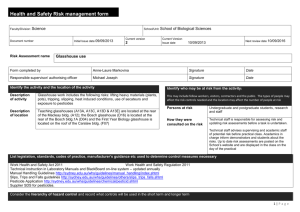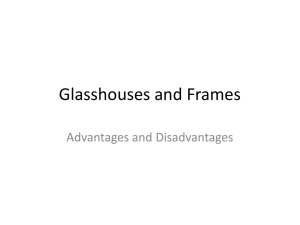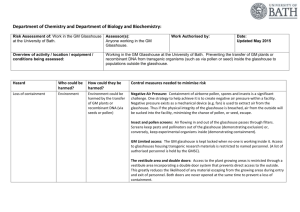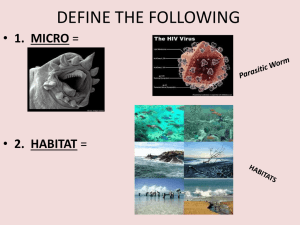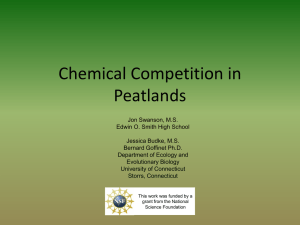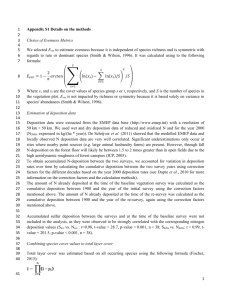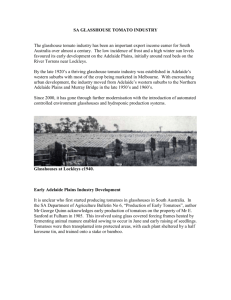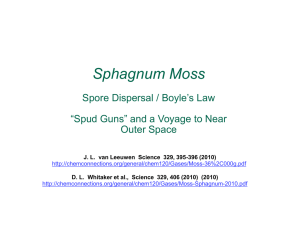NPH_4157_sm_NotesS1
advertisement
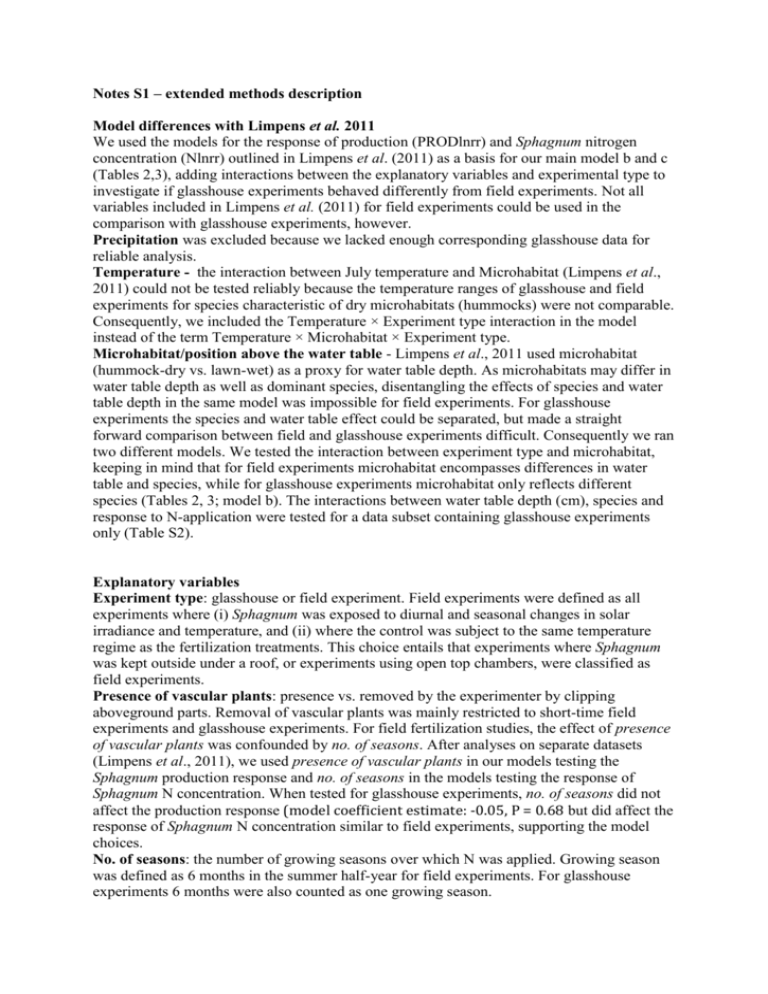
Notes S1 – extended methods description Model differences with Limpens et al. 2011 We used the models for the response of production (PRODlnrr) and Sphagnum nitrogen concentration (Nlnrr) outlined in Limpens et al. (2011) as a basis for our main model b and c (Tables 2,3), adding interactions between the explanatory variables and experimental type to investigate if glasshouse experiments behaved differently from field experiments. Not all variables included in Limpens et al. (2011) for field experiments could be used in the comparison with glasshouse experiments, however. Precipitation was excluded because we lacked enough corresponding glasshouse data for reliable analysis. Temperature - the interaction between July temperature and Microhabitat (Limpens et al., 2011) could not be tested reliably because the temperature ranges of glasshouse and field experiments for species characteristic of dry microhabitats (hummocks) were not comparable. Consequently, we included the Temperature × Experiment type interaction in the model instead of the term Temperature × Microhabitat × Experiment type. Microhabitat/position above the water table - Limpens et al., 2011 used microhabitat (hummock-dry vs. lawn-wet) as a proxy for water table depth. As microhabitats may differ in water table depth as well as dominant species, disentangling the effects of species and water table depth in the same model was impossible for field experiments. For glasshouse experiments the species and water table effect could be separated, but made a straight forward comparison between field and glasshouse experiments difficult. Consequently we ran two different models. We tested the interaction between experiment type and microhabitat, keeping in mind that for field experiments microhabitat encompasses differences in water table and species, while for glasshouse experiments microhabitat only reflects different species (Tables 2, 3; model b). The interactions between water table depth (cm), species and response to N-application were tested for a data subset containing glasshouse experiments only (Table S2). Explanatory variables Experiment type: glasshouse or field experiment. Field experiments were defined as all experiments where (i) Sphagnum was exposed to diurnal and seasonal changes in solar irradiance and temperature, and (ii) where the control was subject to the same temperature regime as the fertilization treatments. This choice entails that experiments where Sphagnum was kept outside under a roof, or experiments using open top chambers, were classified as field experiments. Presence of vascular plants: presence vs. removed by the experimenter by clipping aboveground parts. Removal of vascular plants was mainly restricted to short-time field experiments and glasshouse experiments. For field fertilization studies, the effect of presence of vascular plants was confounded by no. of seasons. After analyses on separate datasets (Limpens et al., 2011), we used presence of vascular plants in our models testing the Sphagnum production response and no. of seasons in the models testing the response of Sphagnum N concentration. When tested for glasshouse experiments, no. of seasons did not affect the production response (model coefficient estimate: -0.05, P = 0.68 but did affect the response of Sphagnum N concentration similar to field experiments, supporting the model choices. No. of seasons: the number of growing seasons over which N was applied. Growing season was defined as 6 months in the summer half-year for field experiments. For glasshouse experiments 6 months were also counted as one growing season. Background N deposition: the wet N deposition rate (g N m-2 yr-1) at the experimental site. For those experiments where vegetation was moved to another site (i.e. all glasshouse experiments), we used wet deposition rate at the collection site. If not provided by the experimenters, wet N deposition rate was extracted from the EMEP website http://webdab.emep.int/Unified_Model_Results/) for the year Sphagnum N concentration data were collected. We selected wet deposition rather than total deposition because of its smaller estimation error (Boring et al., 1988). The EMEP model has been shown to be very accurate for Central and Northern Europe. Validations of EMEP models have given correlation coefficients around ~0.7 for wet and dry deposition (e.g. EMEP Status Report 2007; August 8, 2007, Norwegian Meteorological Institute). N application rate: amounts of N (g N m -2 yr-1) applied by the experimenters. P-application: P (PO43-) applied vs. no P applied. Temperature: mean July temperature at the study site in oC for field studies. For glasshouse studies we used the glasshouse temperature averaged over the experimental period. Microhabitat/ position above water table: species characteristic of hummock (dry) vs. lawn (wet) microhabitats for glasshouse experiments and dry vs. wet microhabitats in field experiments. For more information see previous caption. Scale: the experimental unit, shoots, pot, plot or field used in the experiments. These four groups represent different scales of the experiments; shoot being the smallest and field at the biggest scale. We used this as a crude measurement in a separate model to investigate if there is linear trend with scale. Sphagnum species: the dominant Sphagnum species within the experimental units. Sample size differed widely among species and we could therefore not include species as an additional variable in the main models. Instead, we ran models for those species for which we had a substantial amount of data covering a broad range of our explanatory variables for both glasshouse and field experiments. We performed this analysis for S. fallax, S. magellanicum and S. fuscum. A potential problem in meta-analyses that can lead to biased results is covariates associated with the experimental design. Covariates relevant to our study included the N concentration (g l-1) of the fertilizer solution applied to the experimental unit (N dose concentration), the form (NH4+, NO3-, NH4NO3) in which N was applied (N form) and the frequency (low, medium, high) in which N fertilization was applied (N frequency). N frequency did not affect the responses of Sphagnum in field experiments (Limpens et al., 2011) and could not be analyzed reliably for glasshouse studies as most studies used high application frequencies only (Table 1). Both N form and N dose concentration showed very small effects and were strongly driven by a few data points. When included in models b and c (Table 2,3) they did not affect the main results (Table S2). Exploring N artefacts We compared the relationships between non-standardised Sphagnum N concentration in the upper 0-3 cm of the shoot and N influx between glasshouse and field experiments. We used the same model as Bragazza et al. (2005) and Limpens et al. (2011) as a basis: N concentration = intercept + β × loge(N influx). For field experiments N influx was defined as the sum of background N deposition and N application rate; for glasshouse experiments N influx equalled N application rate. The model was expanded by adding Experiment type and an Experiment type × N influx interaction. The analysis was performed by fitting a generalized least square regression (GLS) using mean N concentration in the treatments as the response variable. A GLS model was applied to account for the within-study correlation with a compound symmetry correlation structure, using the R package nlme (Pinheiro et al., 2009). Weights were used to achieve homogeneity of the residuals applying an exponential variance function structure (Zuur et al., 2009). References Boring LR, Swank WT, Waide JB, Henderson GS. 1988. Sources, fates, and impacts of nitrogen inputs to terrestrial ecosystems: review and synthesis. Biogeochemistry 6:119-59 Bragazza L, Limpens J, Gerdol R, Grosvernier P, Hájek M, Hajkova P, Iacumin P, Kutnar L, Rydin H, Tahvanainen T. 2005. Nitrogen content and δ15N signature of ombrotrophic Sphagnum plants in Europe: to what extent is the increasing atmospheric N deposition altering the N-status of nutrient-poor mires? Global Change Biology 11: 106–114. Limpens J, Granath G, Gunnarsson U, Aerts R, Bayley S, Bragazza L, Bubier J, Buttler A, Van den Berg L, Francez A-J, Gerdol R, Grosvernier P, Heijmans MMPD, Hoosbeek MR, Hotes S, Ilomets M, Leith I, Mitchell EAD, Moore T, Nilsson MB, Nordbakken J-F, Rochefort L, Rydin H, Sheppard LJ, Thormann M, Wiedermann MM, Williams BL, Xu B. 2011. Climatic modifiers of the response to N deposition in peatforming Sphagnum mosses: a meta-analysis. New Phytologist 191: 496-507 Pinheiro J, Bates D, DebRoy S, Sarkar D, the R Core team 2009. Nlme: linear and nonlinear mixed effects models. R package version 3.1-96. Zuur AF, Ieno EN, Walker NJ, Saveliev AA, Smith GM. 2009. Mixed Effects Models and Extensions in Ecology with R. Springer
